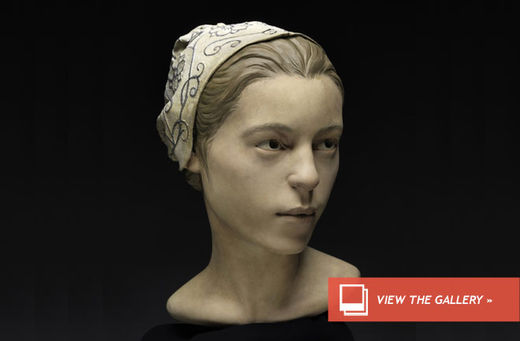
© Don Hurlbert, SmithsonianFacial reconstruction of the cannibalized girl
The first permanent British settlers in North America turned to cannibalism to survive harsh conditions, finds an analysis of human remains with sharp cuts and chopping blows.
Excavated last year from a dump at James Fort in Jamestown, Va., the fragmented remains belonged to a 14-year-old girl and date back to the "starving time" winter of 1609-1610, when three-quarters of the colonists died.
Found with several butchered horse and dog bones, the skeletal remains - a tibia (shin bone) and a skull - featured a series of marks that provide grisly evidence of the dead girl becoming food for the starving colonists.
The researchers were first struck by four shallow chops to the forehead which indicate a hesitant, failed attempt to open the skull.
"The bone fragments have unusually patterned cuts and chops that reflect tentativeness, trial and complete lack of experience in butchering animal remains," Doug Owsley, a forensic anthropologist at the Smithsonian National Museum of Natural History in Washington, D.C., said in a statement.
"Nevertheless, the clear intent was to dismember the body, removing the brain and flesh from the face for consumption," he added.
At last the attempt succeed. A series of deep, forceful chops from a small hatchet or cleaver to the back of the head split the skull open. Flesh was removed from the face and throat using a knife, as sharp cuts and punctures marking the sides and bottom of the mandible, reveal.
The highly fragmented skeleton did not allow the researchers to establish the cause of death of the girl, although a combination of digital and medical technologies made it possible to reconstruct her likeness.
The research team has named her "Jane."
Based on the anthropological evidence of her diet and the archaeological layer where her remains were found, Owsley and colleagues believe "Jane" arrived in Jamestown in August 1609, just months before the deadly "starving time" had begun.
According to Jim Horn, Colonial Williamsburg's vice president of research and historical interpretation and an expert on Jamestown history, the "starving time" was brought about by a series of disasters that struck the community two years after it was established in 1607. These included disease, a serious shortage of provisions, and the siege of the native tribes Powhatan.
"Survival cannibalism was a last resort; a desperate means of prolonging life at a time when the settlement teetered on the brink of extinction," Horn said.
Of about 300 English settlers living at James Fort in the winter of 1609, only about 60 survived to the spring.
The researchers believe it's likely that Jane wasn't a lone case and several other dead bodies were cannibalized.
Indeed, numerous account describing cannibalism surfaced among the survivors soon afterward Lord De La Warr saved Jamestown by sailing into the settlement with food and new colonists.
The facial reconstruction of Jane will be on display on May 3 at the exhibition "
Written in Bone: Forensic Files of the 17th Century Chesapeake" in the National Museum of Natural History.

2012 cannibalism in China
[Link]
2009 cannibalism in Thailand (very very long waiting time)
[Link]